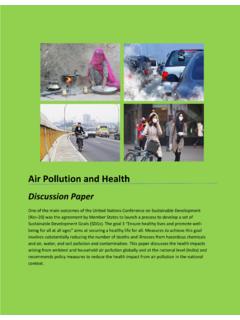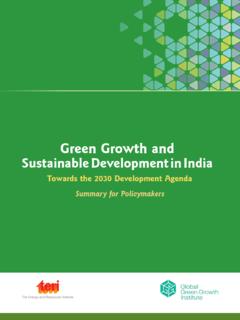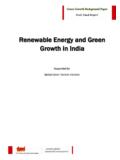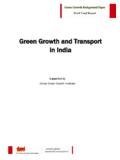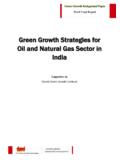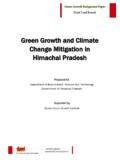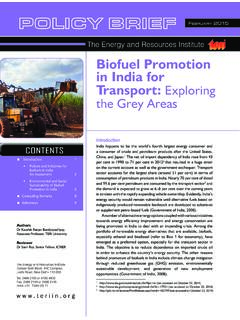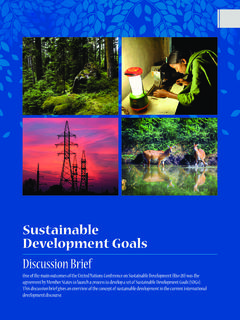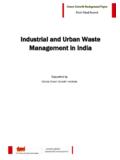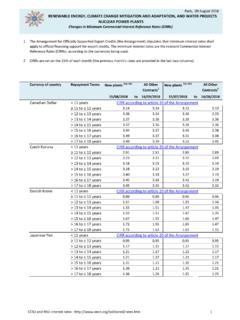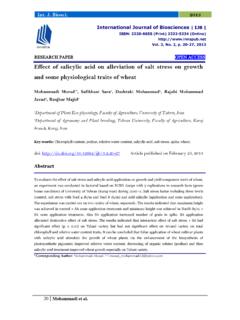Transcription of Green Growth and Renewable Energy in Himachal …
1 Prepared for Department of Environment, Science and Technology Government of Himachal Pradesh Supported by Global Green Growth Institute Green Growth and Renewable Energy in Himachal Pradesh Draft Final Report Green Growth and Renewable Energy in Himachal Pradesh ii The Energy and Resources Institute 2015 Suggested format for citation T E R I. 2015 Green Growth and Renewable Energy in Himachal Pradesh New Delhi: The Energy and Resources Institute. 11pp. Author Ashish John George, Research Associate, TERI Email: Reviewer Shirish S Garud, Associate Director, TERI Email: For more information Project Monitoring Cell T E R I Tel. 2468 2100 or 2468 2111 Darbari Seth Block E-mail IHC Complex, Lodhi Road Fax 2468 2144 or 2468 2145 New Delhi 110 003 Web i i India India +91 Delhi (0)11 Green Growth and Renewable Energy in Himachal Pradesh iiiTable of contents 1 INTRODUCTION.
2 1 2 INSTITUTIONAL SETUP OF THE POWER SECTOR IN Himachal PRADESH .. 2 Renewable Energy Policies of the State .. 3 Small Hydro Power Policy .. 3 Solar Power Policy .. 3 Renewable Purchase Obligations .. 4 3 SOLAR POWER INITIATIVES .. 5 4 SMALL HYDRO POWER INITIATIVES .. 6 5 7 6 WAYS FORWARD .. 8 Short Term .. 8 Medium Term .. 9 Long Term .. 9 7 REFERENCES .. 11 Green Growth and Renewable Energy in Himachal Pradesh ivList of Tables Table 1: RPO for Himachal Pradesh .. 4 List of Figures Figure 1: Renewable Energy Potential in Himachal Pradesh .. 1 Figure 2: Institutional setup of power sector in Himachal Pradesh .. 2 11 Introduction The state of Himachal Pradesh has a geographical area of 55, 673 km2 and lies between altitudes ranging from 350 to 7,000 meters. Most of the area lies above 1,000 meters and is mountainous. Kangra, Mandi and Shimla districts which lie at medium altitudes with respect to the state constitute almost 50% of the total population.
3 The districts lying on the lower altitudes Una, Hamirpur, Bilaspur, Solan although smaller in terms of area, have higher population densities. The major contributor to the GDP of the state is Agriculture. Tourism also plays a predominant role. Energy problems in Himachal Pradesh are complex and area specific necessitating Energy solutions with a decentralized focus. The Integrated Rural Energy Programme (IREP) was formed in response to this. And to provide thrust to this initiative as well as institutionalize programs of Renewable Energy the Himachal Pradesh Energy Development Agency (Himurja) was established in February 1989. The objective of HIMURJA is to promote research and development in the field of non-conventional and Renewable sources of Energy . HIMURJA has been promoting Renewable Energy programs with financial support of the MNRE and the state government.
4 Efforts are continued for the promotion and propagation of Renewable Energy devices such as solar water heating systems, solar Power is one of the most important inputs for economic Growth and overall development of the state. Renewable Energy options such as solar thermal, solar PV and small hydro hold significant potential as part of strategies for Green Growth in Himachal Pradesh. Figure 1 below shows the Renewable potential of Himachal Pradesh. It can be seen that solar and small hydro together exceeds 99% of total estimated potential. Wind, biomass and waste to Energy have very limited power generation potential compared to solar and small hydro and the state has been actively promoting the latter two technologies. Figure 1: Renewable Energy Potential in Himachal Pradesh Source: MN RE An n u al Rep ort 2014 Wind - 64 MW ( ) Small Hydro - 2,398 MW ( ) Biomass - 142 MW ( ) Waste to Energy - 2 MW ( ) Solar - 33,840 MW (93%) Green Growth and Renewable Energy in Himachal Pradesh 22 Institutional setup of the power sector in Himachal Pradesh Through the Himachal Pradesh Power Sector Reforms Transfer Scheme (2010), Himachal Pradesh State Electricity Board Limited (HPSEBL) performs the functions of distribution, trading and generation of electricity while Himachal Pradesh Power Transmission Company Limited (HPPTCL) performs the function of evacuation of power by transmission lines.
5 HPSEBL is responsible for the development, (planning, designing, and construction), operation and maintenance of power distribution system in Himachal Pradesh with inherent trading functions. The HPSERC is the State Electricity Regulatory Commissions created for rationalization of electricity tariff, policies regarding subsidies, promotion of efficient and environmentally benign policies. Himurja is the nodal Renewable Energy authority of the state and has been involved in promotion of renewables and formulation of policy. Department of Energy (DoE) is the state government department that formulates general policy within the general. Figure 2: Institutional setup of power sector in Himachal Pradesh Source: TERI com p ilation Notes: CGS Central Generation Stations, CPP - Captive Power Producer, HPPCL - Himachal Pradesh Power Corporation Limited, IPP Independent Power Producer, HPPTCL - Himachal Pradesh Power Transmission Corporation Limited, SLDC State Load Despatch Centre Green Growth and Renewable Energy in Himachal Pradesh Renewable Energy Policies of the State Small Hydro Power Policy As a source of Energy hydro power is economically viable, non-polluting and is environmentally sustainable.
6 The Power Policy of the State attempts to address all aspects like capacity addition Energy security, access and availability, affordability, efficiency, environment and assured employment to people of Himachal . The Small Hydro Power Policy came into force in 2006 and was amended in January 2010. The policy is applicable to hydro systems up to MW. The main features of the policy are: SHP projects of up to 2 MW are reserved for Himachali and Cooperative Societies comprising Himachalis. Furthermore preference is given for Himachalis until 5MW. The state government would acquire land for permanent structures and land for other purposes would be leased out by Government at approved rates. Operative period of the projects under this policy is 40 years after which the projects would be handed over to the Government. Power generated will be sold to HP State Electricity Board preferentially and if the developer intends to sell the power to a third party he is free to do so at a higher cost.
7 Wheeling charges for captive use is at 2% including losses and for sale and captive use of power outside HP, it would be 1% of the Energy received. No water royalty up to 5 MW for 12 years, 12% for next 18 years and beyond at 18% for sale within the state. For new projects upfront premium exempted for project capacity up to 2 MW Solar Power Policy Himachal Pradesh Solar Power Policy of 2014 has policy targets to promote solar initiatives in the state. The policy targets 50 MW of solar power installation from 2013 to 2017 (Phase I) and 250 MW from 2017 to 2022 (Phase II) JNNSM. Promotion of off-grid and decentralized solar applications Promotion of grid connected solar plants Category I (up to 100 kWp) o Domestic consumers Category II (Integrated rooftop/small solar plants up to 1 MW) o Group of individuals, housing colonies, rural/urban housing schemes Green Growth and Renewable Energy in Himachal Pradesh 4 Category III (Solar power plants from 100 kWp to 500 kWp) o Commercial, industrial, educational institutions and government buildings Category IV (Solar power plants from 100 kWp to 500 kWp) o Solar plants installed on owned land or land leased from government/private entity Category V (Solar power plants above 500 kWp) Tariff to be determined by HPERC on net metering basis (for categories I,II and III) and on competitive bidding basis (for categories IV and V)
8 Nodal agency has been directed to facilitate and monitor solar power projects. Single window clearances to be provided. Solar power producers are responsible for evacuation up to the Interconnection point with HPSEB/HPPTCL at their own cost. Captive consumption, REC mechanism, sale of power to Discoms at FiT and third party sale are allowed. Developer to ensure 70% employment to be reserved for Himachalis Exemption from payment of electricity tax to the extent of 100% on electricity generated from solar power projects used for self-consumption/sale to utility for first 5 years. Renewable Purchase Obligations The Himachal Pradesh Electricity Regulatory Commission (HPERC) has brought out the Renewable Power Purchase Obligation and its Compliance Regulations, 2010 that specifies the quantum of Renewable Power Purchase Obligations (RPPO) from solar and non-solar sources.
9 The obligated entities include the distribution licensee, captive and open access consumers. Table 1 below specifies the RPO obligations for the state. Table 1: RPO for Himachal Pradesh Year Minimum Purchase from Renewable sources Total RPPO (%) Solar RPPO (%) 2011-12 2012-13 2013-14 2014-15 Green Growth and Renewable Energy in Himachal Pradesh 52015-16 2016-17 2017-18 2018-19 2019-20 2020-21 2021-22 Source: HPERC RPPO regulations 3 Solar Power Initiatives Himachal Pradesh is a hilly state with generally clear sky. The average solar insolation in the state ranges between with around 300 clear sunny days in a year. However solar power is expensive when compared to abundant and cheap hydro-electric power (with huge potential in the state). HPSERC has however made it mandatory for discoms and obligated consumers to purchase a percentage of power from solar project.
10 Additional factors to be considered are that the cold desert region in Lahaul & Spiti and part of Kinnaur districts are remote and do not have sufficient power evacuation arrangements. Solar Water Heating System: HIMURJA has been recognized as the best state-based nodal agency in the areas of promotion and market development of solar water heaters by the MNRE. Solar water heating systems of 1,629,970 liters per day capacity have been installed in different parts of the state (as on March 2014). A target of installing 200,000 LPD was been proposed for 2014 under the JNNSM. Solar water heating systems of 271200 LPD capacity have been installed through Market Mode under Jawaharlal Nehru National Solar Mission (JNNSM), in the different parts of the State up to December, 2014. Most of Himachal Pradesh is over 1,000 meters above sea level and is covered by mountains and hence the need for water heater also arises due to firewood shortage.

